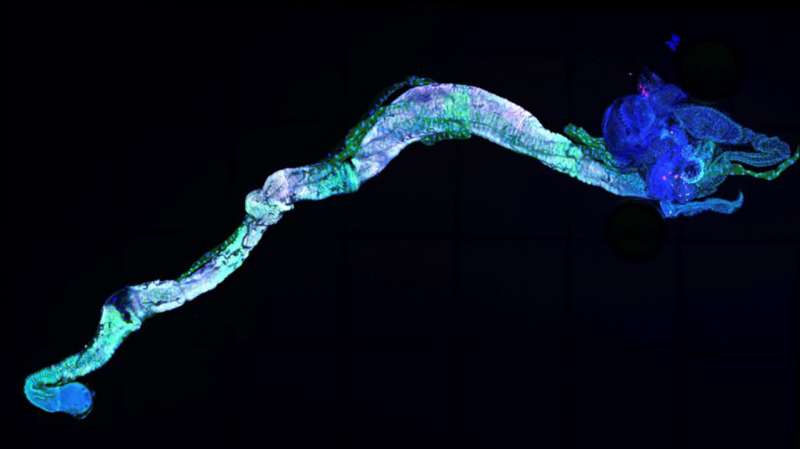This article has been reviewed according to Science X's editorial process and policies. Editors have highlighted the following attributes while ensuring the content's credibility:
fact-checked
peer-reviewed publication
trusted source
proofread
Newly discovered receptor influences gut development in fruit flies

Adhesion GPCRs are a group of G protein-coupled receptors associated with many bodily functions and diseases in humans. Scientists at Leipzig University have discovered a new receptor—which they have named "mayo"—and found that it influences the development of the small intestine and heart function in fruit flies, and that these phenomena may also be relevant in humans.
Their findings have now been published in the journal Cell Reports.
Adhesion GPCRs belong to the large family of G protein-coupled receptors (GPCRs). There are about 700 variants in humans, which are responsible for sensory impressions, hormonal cycles, controlling the cardiovascular system and more. GPCRs translate stimuli that hit a cell from outside into an intracellular biochemical signal.
The use of the fruit fly as a model animal allows researchers in this field to gain a deep understanding of human diseases, because the animals are genetically very similar to humans. Scientists estimate that about 75% of the genes involved in human diseases are also found in fruit flies.
The research team at the Rudolf Schönheimer Institute of Biochemistry at the Faculty of Medicine has discovered three new adhesion GPCR genes in the genome of the fruit fly, or Drosophila. One of them is very old in evolutionary terms, and has been called mayo. In the current publication, the Leipzig scientists demonstrate the functions of this adhesion GPCR using the fruit fly as a living model.
"We found that mayo affects the development of the midgut in Drosophila by promoting the growth of enterocytes, the epithelial cells of the intestinal mucosa," says Dr. Beatriz Blanco-Redondo, corresponding author of the study.
In the publication, the Leipzig scientists also show that the loss of mayo in the intestine accelerates the heart rate of the animals and that they develop dangerous palpitations. The results indicate that the functions of the intestine and heart are linked through the role of mayo in the proliferation of enterocytes. These regulate and secondarily govern ion uptake, systemic potassium levels and heart rate.
The researchers at Leipzig University studied animals in which the mayo gene had been switched off. They found that these "knockout animals" displayed elongated guts. A similar genetic picture was observed after overexpression of another adhesion GPCR in mouse intestinal cells, resulting in a mega-intestine. The study shows that adhesion GPCRs are also involved in the development of the gastrointestinal tract in other species and that these phenomena may be relevant in humans.
"We are only at the beginning of this research project. The main goal is to identify the signaling pathway in which the adhesion GPCR mayo is involved in order to find out how it controls intestinal development," says Tobias Langenhan, Professor of General Biochemistry at the Rudolf Schönheimer Institute and also corresponding author of the study.
More information: Fernando Vieira Contreras et al, The adhesion G-protein-coupled receptor mayo/CG11318 controls midgut development in Drosophila, Cell Reports (2024). DOI: 10.1016/j.celrep.2023.113640




















